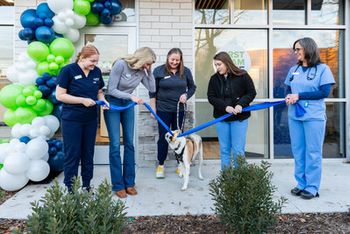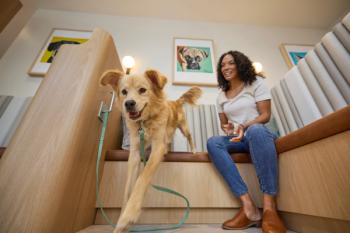
Hanging with Hafen: How to design for more "dog time"
Are you and your team members spending too much time away from patients? Here are a few tips for building a more efficient facility.
Are you knee-deep in a construction project, wondering why the guy in the trench outside is leaning on his shovel instead of getting the job done? Well, wonder no more.
I just finished reading an article titled “Craft productivity improvement programs” in Engineering News Record. Interestingly, the article states that only about 29 percent of the time the average construction worker puts in on the job is “wrench time,” or direct hands-on production time. Here’s what a typical construction worker’s day looks like (numbers are approximate):
29%: Wrench time
19%: Tools and equipment
17%: Travel
13%: Waiting
11%: Preparation
8%: Materials
5%: Personal
On a given day, approximately 2.5 hours are directly productive, while 5.5 are spent “getting ready.” Let’s look at how this compares to your veterinary practice.
If “wrench time” is only 29 percent of a construction day, then how much direct, productive “dog time” occurs in your veterinary practice? For the sake of simplicity, let’s take client relations and exams out of the formula. This is not to say those activities aren’t important, because without them you have no practice. But let’s look specifically at how to make your in-house medical procedures more efficient.
Dog time (29 percent)
This is time actually treating, monitoring, or “working” on an animal.
Tools and equipment (19 percent)
This would include the time your team members devote to the interface between themselves and:
> Handheld equipment like scopes, lasers, electrical scalpels, otoscopes, and blood pessure monitors
> Countertop equipment like microscopes and blood chemistry analyzers
> Freestanding equipment like c-arms, radiograph machines, and ultrasound equipment.
In all of these cases, the goal is to have the equipment readily available, clean, and operable. Handheld equipment should be cleaned and stored where you could find it, and countertop and other large-scale equipment should be located where the actual procedure is taking place. For permanently installed equipment, there should be enough extra space to use it effectively.
For example, build into your design convenient places to park wheeled equipment like gurneys, dental radiography units, crash carts, and anesthetic machines close to where they’ll be used.
Travel (17 percent)
Do you need running shoes to get from one end of the facility to the other? Again, the location of your materials and equipment is important, but you should also try to organize your facility into functional groupings with ideal adjacencies. For example, in many new facilities, ward spaces are located close to the treatment area so travel time to transport animals and even monitor them is kept to a minimum.
Waiting (13 percent)
Toyota has made the Lean manufacturing process, a method centered on preserving value with less work—and specifically, “just in time” material delivery—a crucial part of its success. “Just in time,” when applied to a veterinary practice, would mean:
> Having doctors where you need them when you need them
> Having patients there, too
> Having the materials and equipment you need
> Having the space to do the work required
What’s the cost of waiting in your existing practice? How many veterinarians are overbooked on dental procedures or examinations? How much income are you losing because you don’t have enough treatment tables and surgeries? One solution we’ve been integrating into our designs is multi-function rooms. These spaces work double-duty as exam rooms during peak hours, and then through the use of a sliding door become an extra treatment station during the rest of the day.
Many human hospitals use locator tags and badges to cut down on wait time lost when doctors go missing. Locator tags have also been used in the construction industry and even long-haul trucking to keep track of lost equipment and materials. Perhaps these same technologies could be used in your hospital to eliminate waiting and lost resources.
Preparation (11 percent)
Do you fold packs on top of your washing machines or radiography tables? Wouldn’t it make more sense to design an alcove specifically to prepare surgical packs? This space could also include room for a sink, autoclave, and washer-dryer so that everything you need to prepare a surgical pack is in one place.
Materials (8 percent)
Materials should also be organized an accessible. For example, are you storing dog food and dry goods in your hallways, cages, and dog runs? Consider including a food storage closet near the reception desk in your design so receptionists can quickly grab a case of prescription food instead of walking to the back of your facility.
Another time-saving example: We often design a utility column as part of a practice’s treatment station. In this column, we build a number of shallow shelves to store materials frequently used in routine medical procedures.
Personal (5 percent)
It’s not realistic or even desirable to eliminate personal time. Team members (and you) need time to breathe. It makes sense for this time to be as beneficial as possible. Perhaps you could include a designated “quiet room” in your facility, a gym, or an outdoor patio. Even the smallest corner with a microwave, coffee pot, table, and refrigerator can be a good spot for a rest. And if you locate this mini-break corner close to where the action is, then you won’t spend time trying to find people. This allows team members to grab more break time even when they’re on the run.
Making significant changes to the way you practice medicine or the way you design your next facility may seem daunting. But take solace in a favorite axiom of mine: “If you’re digging yourself a hole, the first thing you’ve got to do is stop digging.” In other words, first redirect your efforts, even if just a little. If you can make things better to the tune of just 1 percent per category, that would translate to a total gained efficiency of 6 percent. In a practice that grosses $1 million, that would be an increase of $60,000. And even if it results in an initial capital cost, the increase in efficiency will keep on giving year after year. That sure is better than just digging a hole.
Newsletter
From exam room tips to practice management insights, get trusted veterinary news delivered straight to your inbox—subscribe to dvm360.




